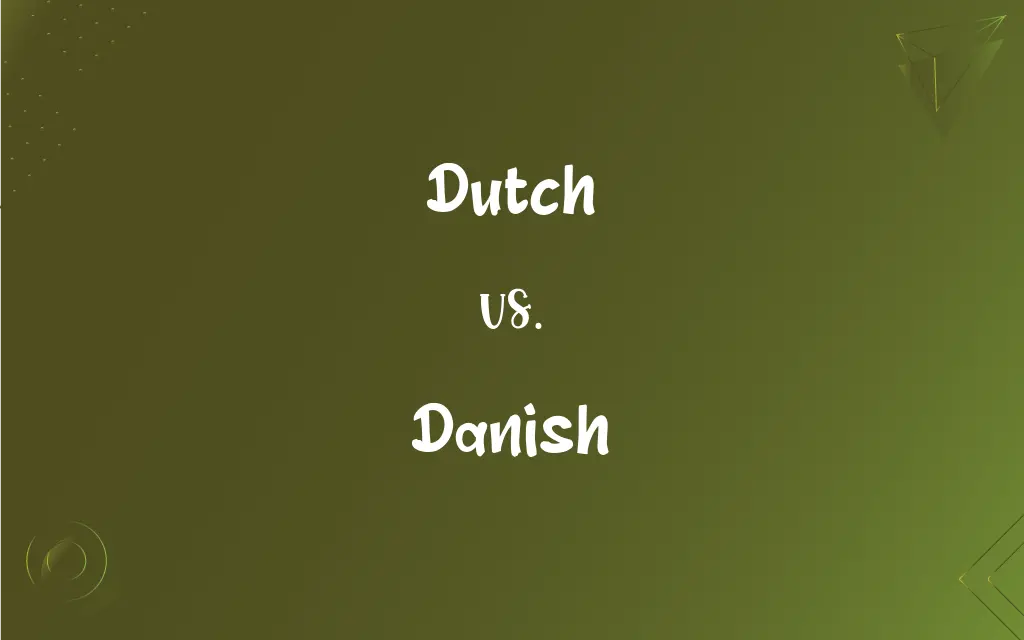Dutch vs. Danish: What's the Difference?
Edited by Janet White || By Harlon Moss || Updated on October 18, 2023
Dutch refers to things from the Netherlands, while Danish pertains to Denmark.

Key Differences
Dutch and Danish, though sounding somewhat similar, are distinctly different and pertain to two separate European countries. The term "Dutch" relates to the Netherlands, its people, and its language. It encompasses a rich history of art, maritime prowess, and engineering feats, such as the creation of polders and canals.
Danish, on the other hand, is associated with Denmark, its inhabitants, and its language. Denmark is part of Scandinavia and boasts its Viking heritage, historical castles, and popular contemporary contributions such as LEGO and the concept of "hygge".
When speaking about language, Dutch is a West Germanic language spoken mainly in the Netherlands and Belgium. It has its roots in the same family as English and German, and many Dutch words might sound or look familiar to speakers of these languages.
Danish, meanwhile, is a North Germanic or Scandinavian language. It's spoken in Denmark and parts of Greenland. Though it shares the Germanic roots with Dutch, its vocabulary, pronunciation, and syntax can be vastly different due to the influence of neighboring Nordic languages.
Comparison Chart
Country
Netherlands
Denmark
ADVERTISEMENT
Region
Western Europe
Scandinavia/Northern Europe
Language Family
West Germanic
North Germanic (Scandinavian)
Script
Latin script
Latin script with special characters
Close Relatives
Flemish, Afrikaans
Swedish, Norwegian
Dutch and Danish Definitions
Dutch
Characteristic of or attributed to the Dutch.
Dutch courage refers to bravery after consuming alcohol.
ADVERTISEMENT
Danish
Characteristic of or attributed to the Danish.
The concept of hygge is uniquely Danish.
Dutch
Relating to the Netherlands.
The Dutch countryside is filled with tulip fields.
Danish
The North Germanic language of Denmark.
He learned Danish to communicate with his grandparents.
Dutch
Referring to a split or shared cost.
Let's go Dutch on dinner tonight.
Danish
Relating to Denmark.
The Danish monarchy is one of the oldest in the world.
Dutch
The West Germanic language of the Netherlands.
She speaks Dutch fluently.
Danish
Referring to Denmark's style or contributions.
The Danish design philosophy emphasizes simplicity and functionality.
Dutch
Pertaining to a specific method or style from the Netherlands.
The Dutch oven is popular for slow-cooking dishes.
Danish
A type of pastry.
I love having a Danish with my morning coffee.
Dutch
Of or relating to the Netherlands or its people or culture.
Danish
Of or relating to Denmark, the Danes, their language, or their culture.
Dutch
Of or relating to the Dutch language.
Danish
The North Germanic language of the Danes.
FAQs
Is Dutch a language?
Yes, it's the official language of the Netherlands.
Are Dutch and Danish from the same language family?
No, Dutch is West Germanic while Danish is North Germanic.
What country is associated with "Dutch"?
The Netherlands.
Can you name a popular Danish dish?
Smørrebrød, which is an open-faced sandwich.
Does the Dutch language have dialects?
Yes, there are various regional dialects in the Netherlands.
Is Danish also a language?
Yes, it's the official language of Denmark.
Is "Dutch courage" about the bravery of the Dutch people?
It's an idiom referring to bravery from consuming alcohol.
Is "hygge" a Dutch concept?
No, it's a Danish concept about coziness and contentment.
Which language has closer ties to English, Dutch or Danish?
Dutch, as both are West Germanic languages.
What is a "Dutch door"?
It's a door divided horizontally, allowing the top half to open separately from the bottom.
Are the Dutch and Danish geographically close?
They are both in Northern Europe, but Denmark is in Scandinavia, while the Netherlands is further south.
Is LEGO Dutch or Danish?
Danish, LEGO originated in Denmark.
Is Danish spoken in countries other than Denmark?
Yes, it's spoken in Greenland as well.
Are there different dialects in the Danish language?
Yes, Danish has regional variants and dialects as well.
Which country is related to the term "Danish"?
Denmark.
Are Danish pastries from Denmark?
Yes, they originated in Denmark.
What's a typical Dutch dish?
Stamppot, which is mashed potatoes mixed with vegetables.
Is the Dutch language spoken outside of the Netherlands?
Yes, it's also spoken in parts of Belgium and Suriname.
What script do the Dutch use?
Latin script.
What script is used for Danish?
Latin script with special characters.
About Author
Written by
Harlon MossHarlon is a seasoned quality moderator and accomplished content writer for Difference Wiki. An alumnus of the prestigious University of California, he earned his degree in Computer Science. Leveraging his academic background, Harlon brings a meticulous and informed perspective to his work, ensuring content accuracy and excellence.
Edited by
Janet WhiteJanet White has been an esteemed writer and blogger for Difference Wiki. Holding a Master's degree in Science and Medical Journalism from the prestigious Boston University, she has consistently demonstrated her expertise and passion for her field. When she's not immersed in her work, Janet relishes her time exercising, delving into a good book, and cherishing moments with friends and family.
































































